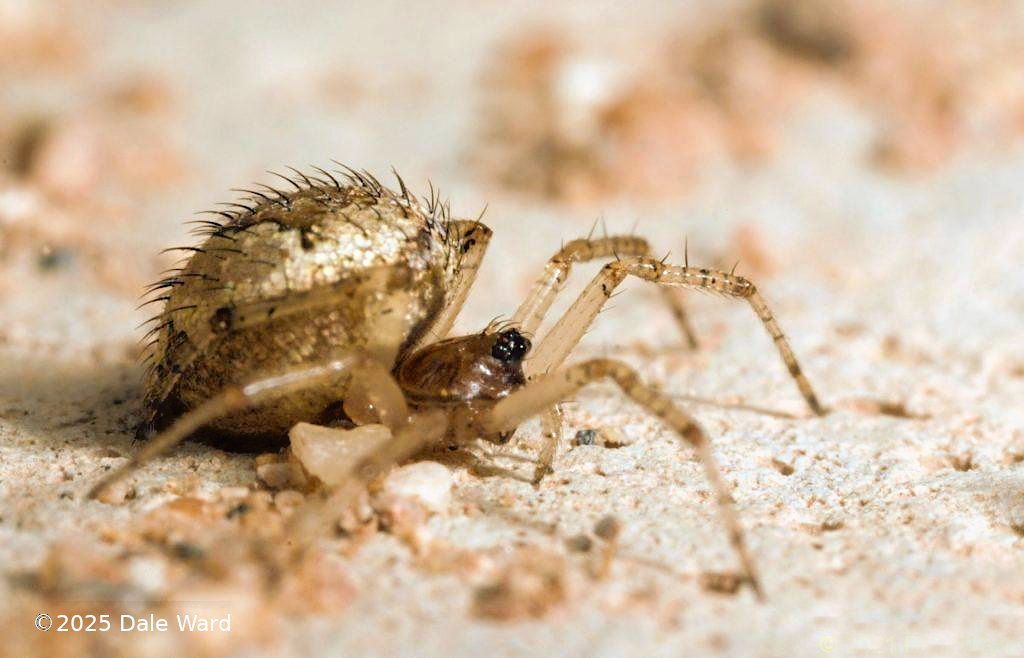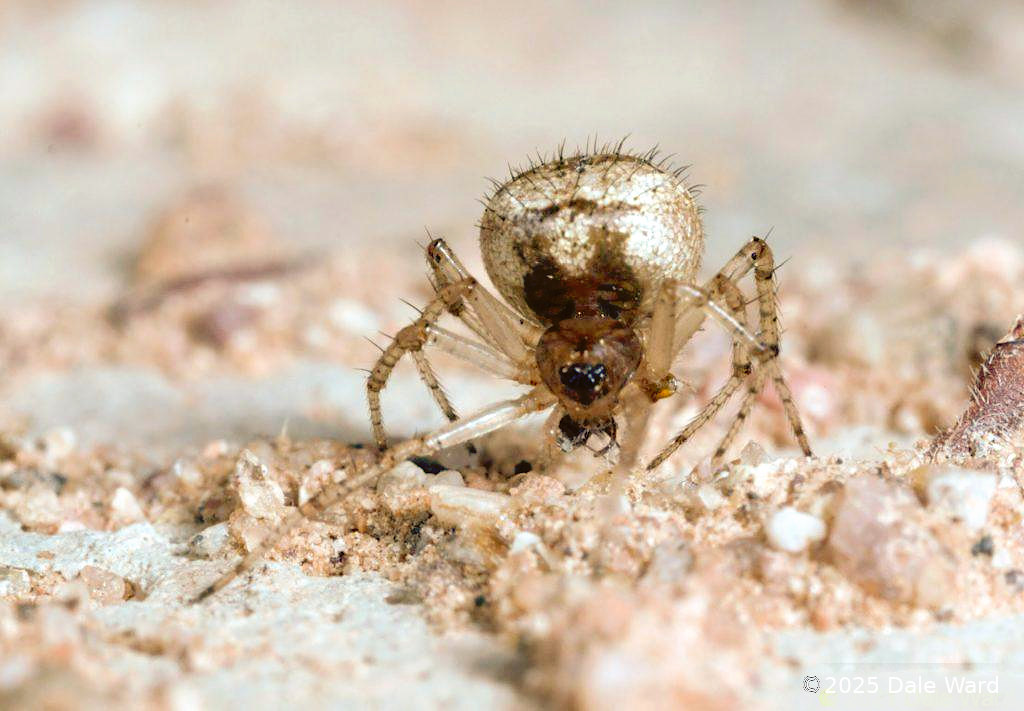Euryopis spiders and Pogonomyrmex rugosus Ants - Some Enchanted Evening
Euryopis spiders killing Rough Harvester Ants (and Forelius!) on a night in Tucson, Arizona
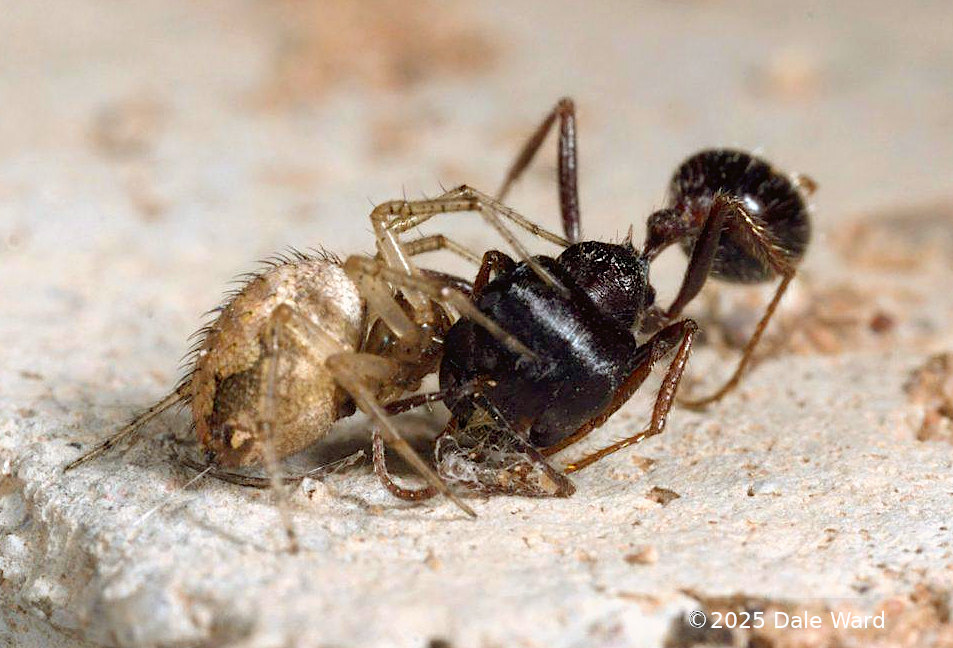 Female _Euryopis_ with captured _Pogonomyrmex rugosus_ worker
Female _Euryopis_ with captured _Pogonomyrmex rugosus_ worker
On August 13, 2005, I was walking through our South Tucson neighborhood after dark. There was a lot of Sonoran upland desert in our housing area, and it was surprising how many neat things you could see while out at night.
I walked by one of my favorite Pogonomyrmex rugosus (Rough Harvester Ant) nests. This was one of my favorite nests because it was next to the sidewalk. I would often photograph ants here because it was more comfortable to lay down on the relatively smooth, gray surface of the sidewalk than on the desert floor.
On this particular night, what I saw was a group of spiders attacking my Harvester Ants.
It was an aggregation of Euryopis spiders. There were probably six or eight spiders around the nest - I forget exactly how many there were. It was a mixed group of male and female spiders. One of the interesting things about these spiders is that they are ant-predator specialists.
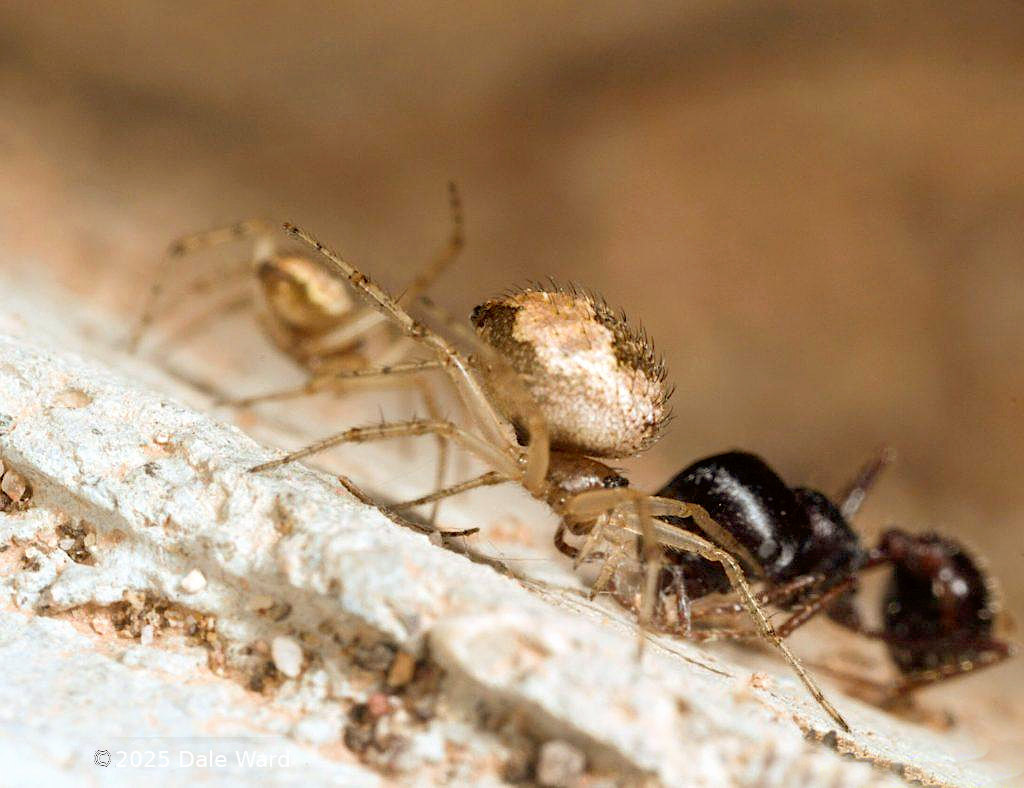 Female _Euryopis_ with captured _Pogonomyrmex rugosus_ worker. You can see an out-of-focus male _Euryopis_ spider behind the female.
Female _Euryopis_ with captured _Pogonomyrmex rugosus_ worker. You can see an out-of-focus male _Euryopis_ spider behind the female.
The females seemed to be concentrating on catching ants. They would run around the ants, spinning silk as they went, so that the ants would become entangled in the web. Then the spider would rush in and bite the ant. I vaguely recall that the bites were on the hind leg joints of the ants, but I don’t remember for-sure.
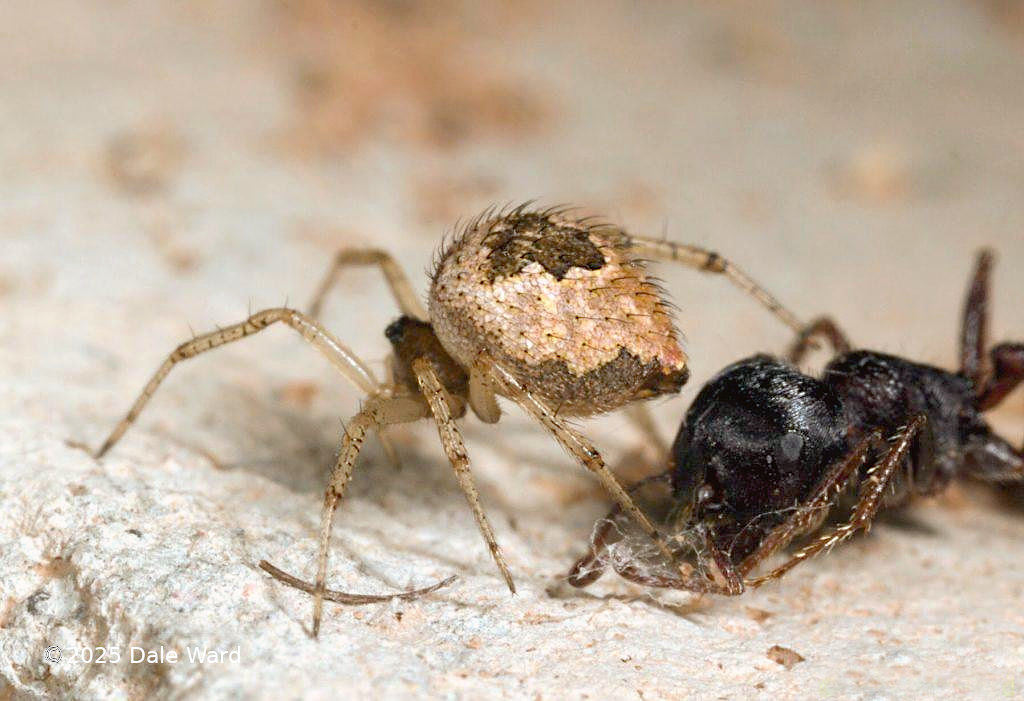 Female _Euryopis_ spider with captured _Pogonomyrmex rugosus_ worker.
Female _Euryopis_ spider with captured _Pogonomyrmex rugosus_ worker.
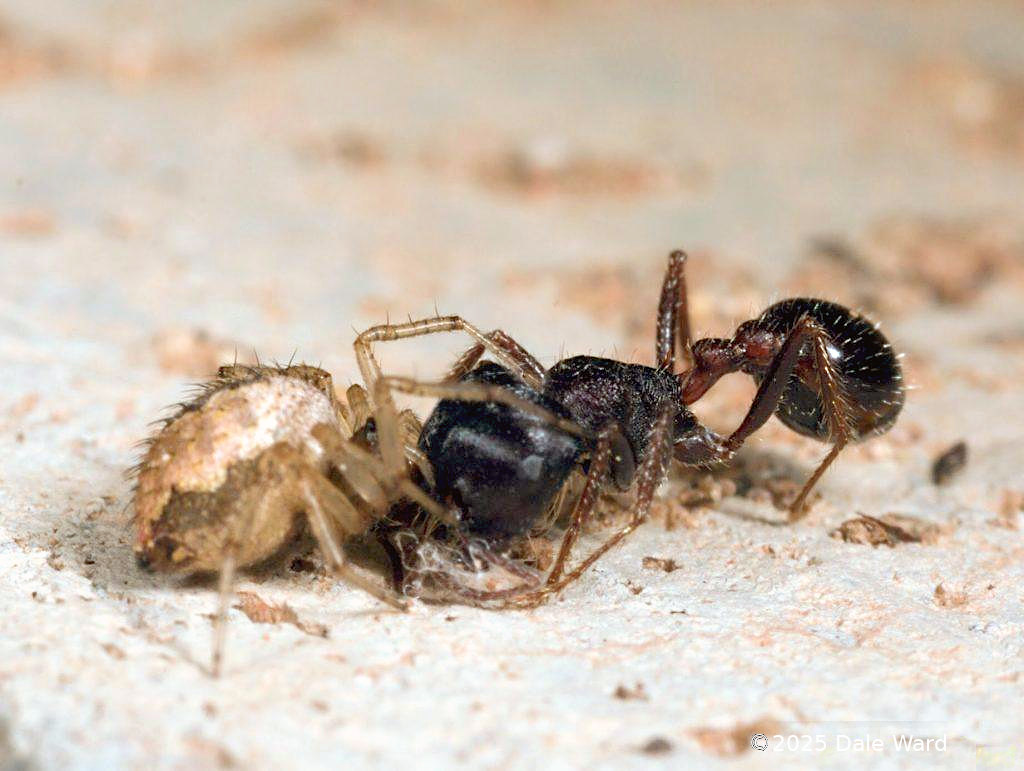 Female _Euryopis_ with captured _Pogonomyrmex rugosus_ worker
Female _Euryopis_ with captured _Pogonomyrmex rugosus_ worker
The males spiders seemed more interested in the females than they were in the ants. The males would dart in towards the females, and the females would sort of lunge at the males, driving them away.
But it seemed that the males were more successful in approaching the females after the females had captured an ant. The male would approach the female when she was on her ant prey, and the female would not lunge at the male. Rather, she would leave the ant and mate with the male.
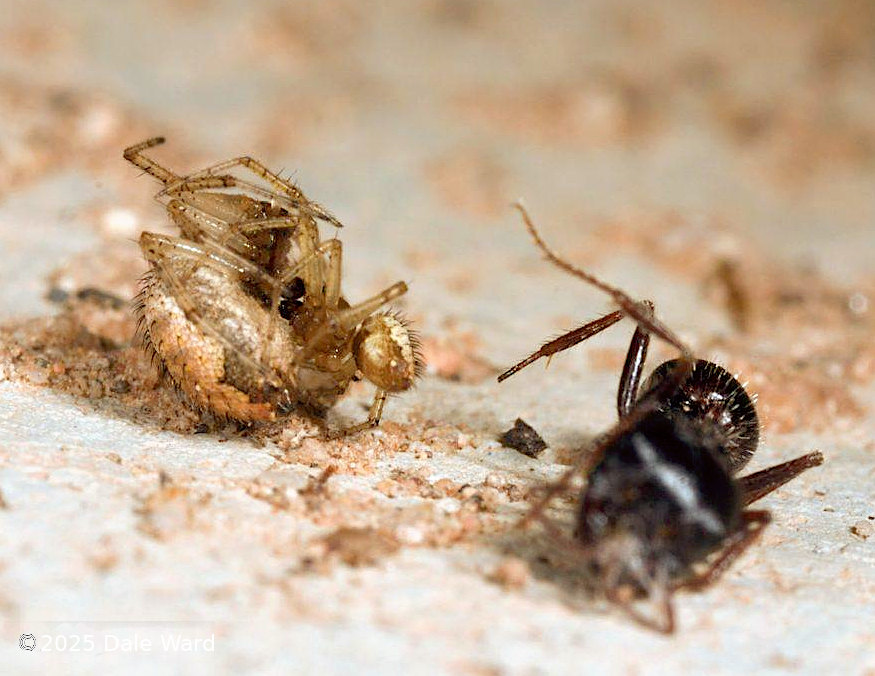 Male _Euryopis_ spider (small spider on right) mates with female (large spider on left), captured _Pogonomyrmex_ worker in foreground.
Male _Euryopis_ spider (small spider on right) mates with female (large spider on left), captured _Pogonomyrmex_ worker in foreground.
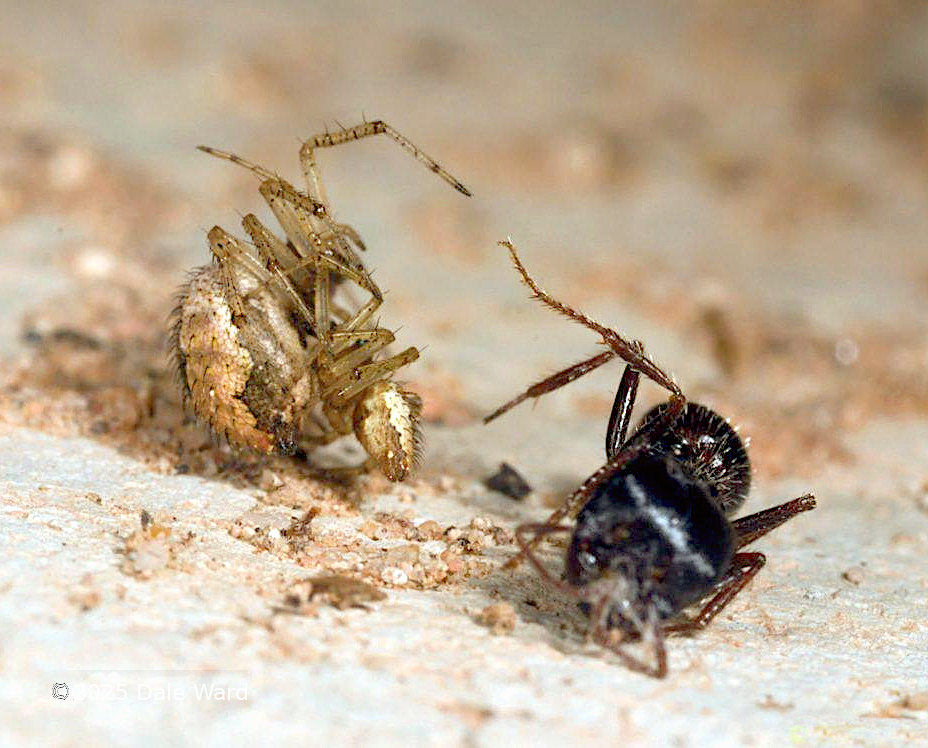 Male _Euryopis_ spider (small spider on right) mates with female (large spider on left), captured _Pogonomyrmex_ worker in foreground.
Male _Euryopis_ spider (small spider on right) mates with female (large spider on left), captured _Pogonomyrmex_ worker in foreground.
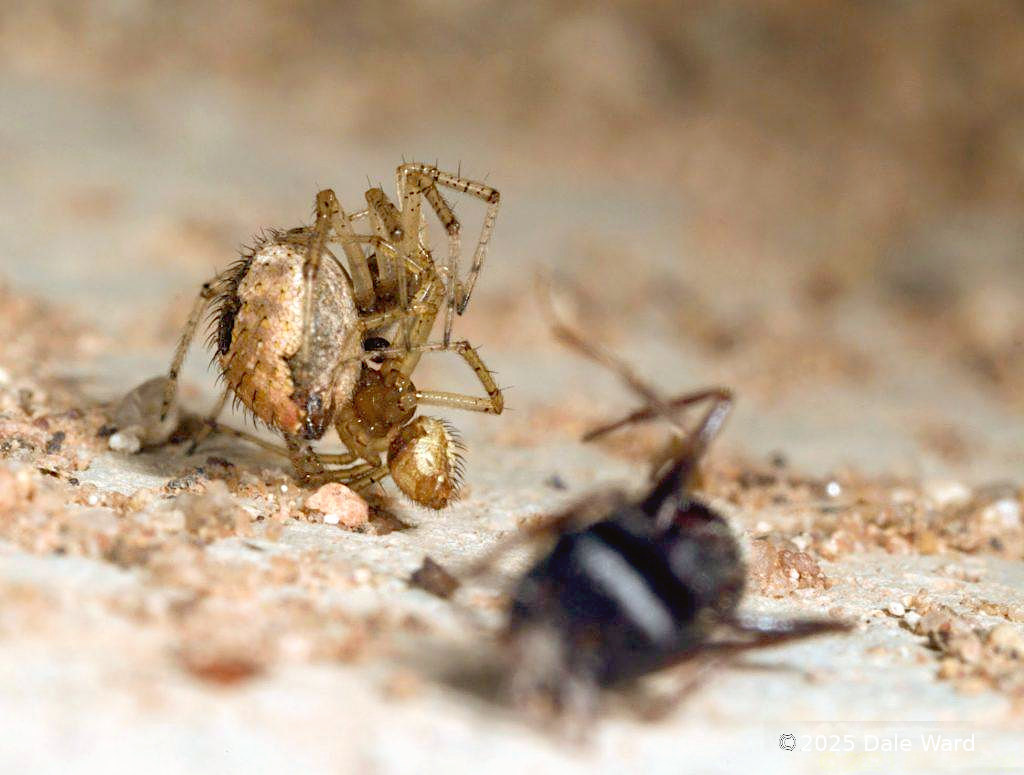 Male _Euryopis_ spider (small spider on right, under female) mates with female (large spider on left), captured _Pogonomyrmex_ worker in foreground.
Male _Euryopis_ spider (small spider on right, under female) mates with female (large spider on left), captured _Pogonomyrmex_ worker in foreground.
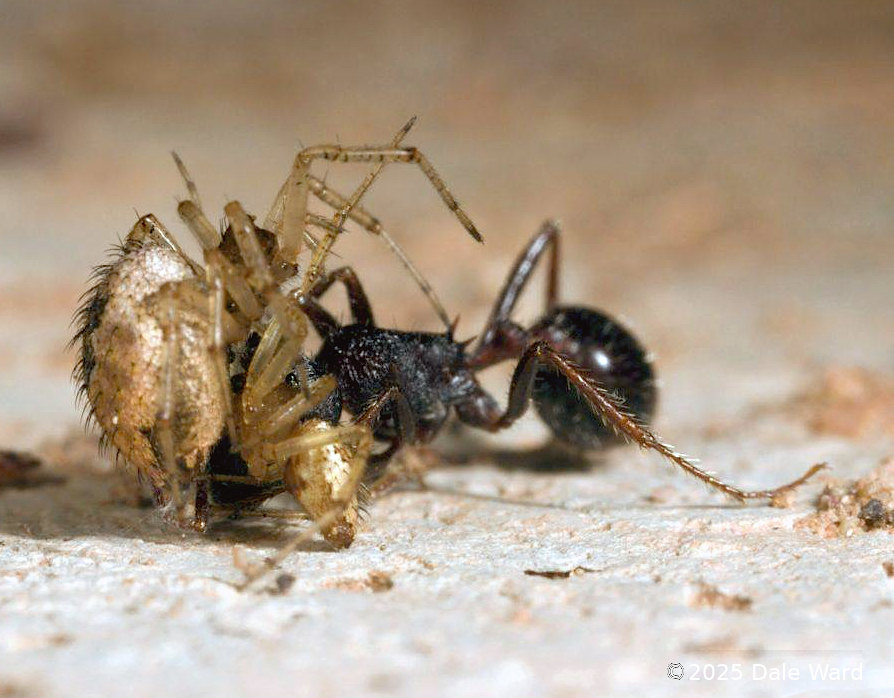 Male and Female _Euryopis_ with captured _Pogonomyrmex rugosus_ worker. The male is approaching again, after he has mated with the female.
Male and Female _Euryopis_ with captured _Pogonomyrmex rugosus_ worker. The male is approaching again, after he has mated with the female.
After mating, the male would sometimes return to the female. It looked like he might have been feeding on the female’s ant. She wouldn’t chase him away…
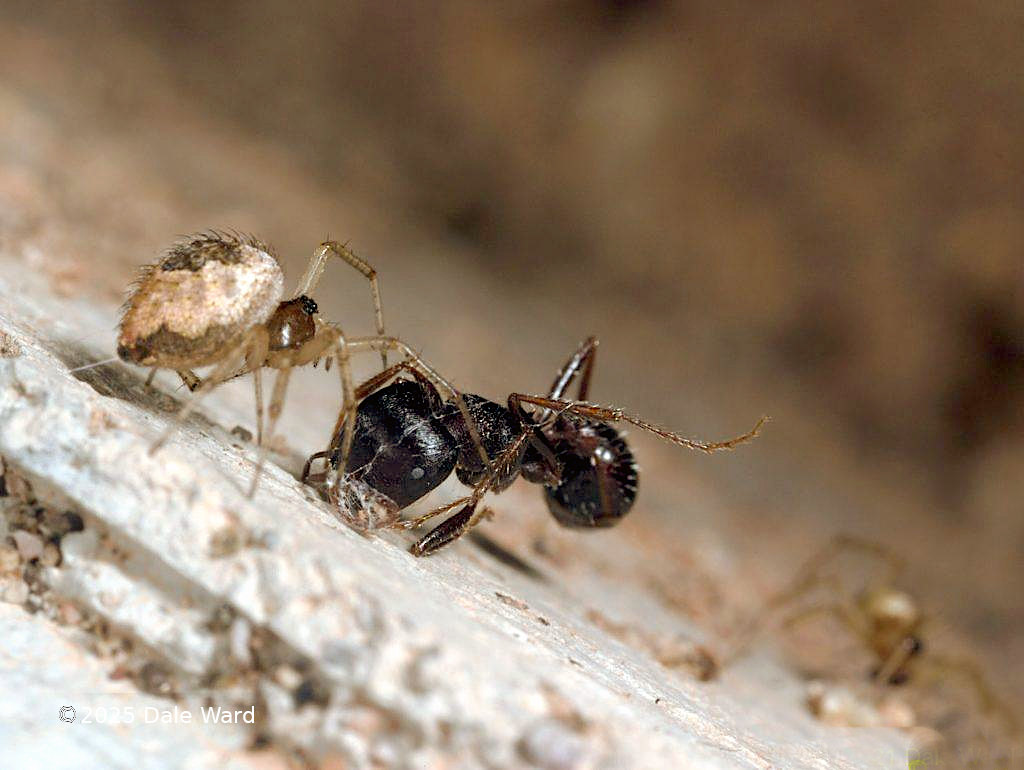 _Euryopis_ female (left) with captured P_ogonomyrmex rugosus_ worker. You can see a male _Euryopis_ in the lower right background of the photo. This is after mating. The male would return to the female, leave, return…
_Euryopis_ female (left) with captured P_ogonomyrmex rugosus_ worker. You can see a male _Euryopis_ in the lower right background of the photo. This is after mating. The male would return to the female, leave, return…
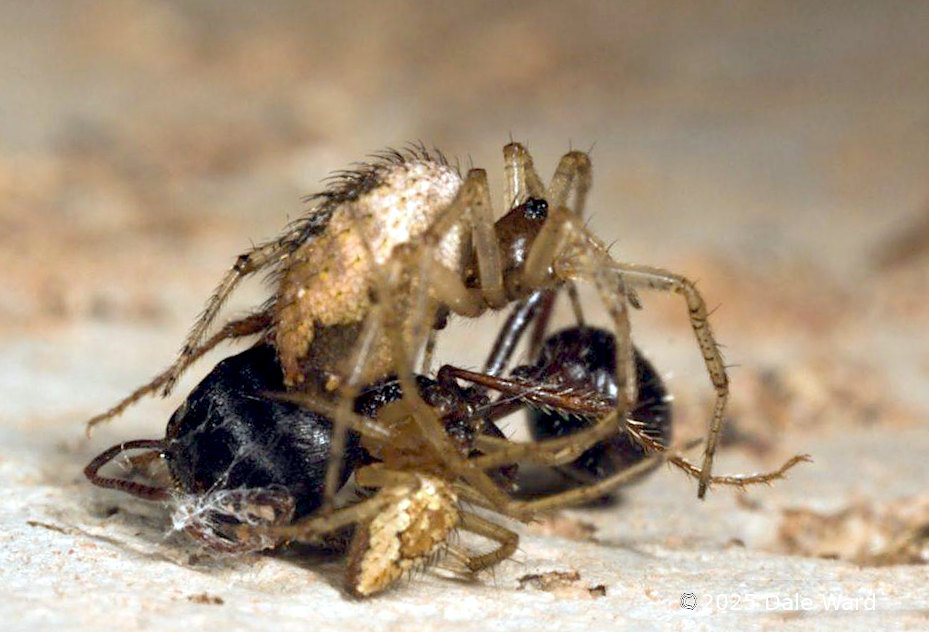 Male _Euryopis_ spider (small spider) and female (large spider), captured _Pogonomyrmex_ worker. This is after the mating. I _think_ the male may be feeding on the female’s capture in this photograph.
Male _Euryopis_ spider (small spider) and female (large spider), captured _Pogonomyrmex_ worker. This is after the mating. I _think_ the male may be feeding on the female’s capture in this photograph.
Interestingly, the Euryopis were not eating just Pogonomyrmex rugosus ants. A small Dolichoderine ant, Forelius pruinosus, came wandering through the area. A female Euryopis quickly wrapped and bit the ant.
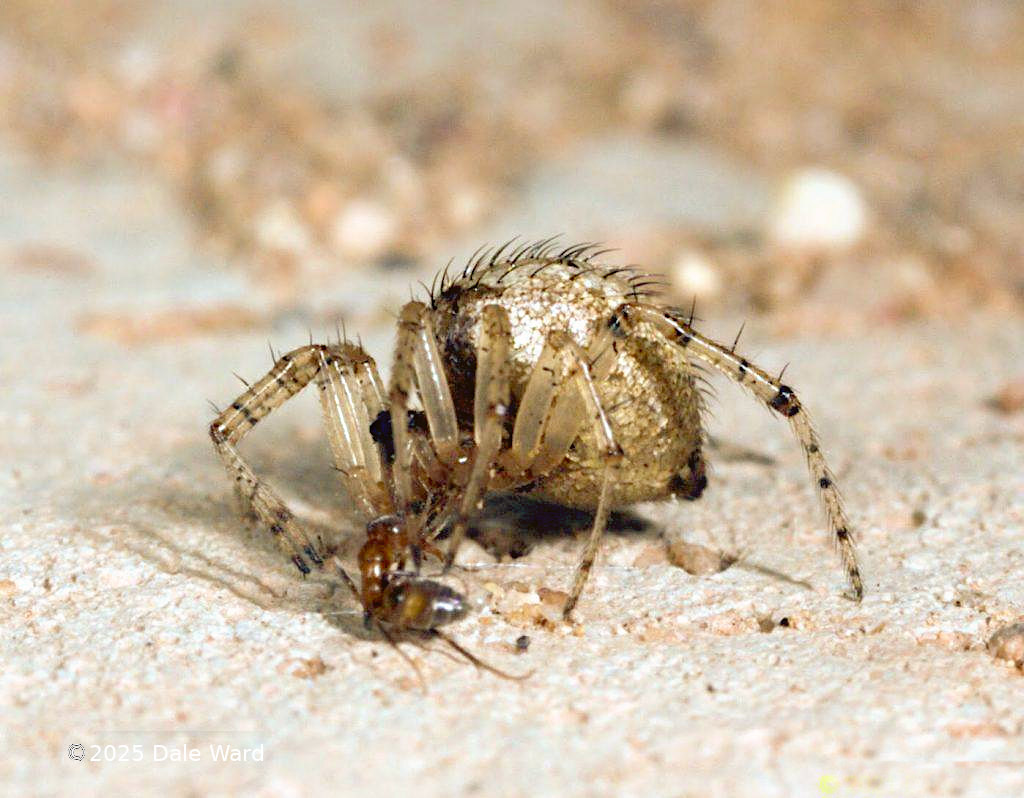 Female _Euryopis_ spider with captured _Forelius pruinousus_ worker
Female _Euryopis_ spider with captured _Forelius pruinousus_ worker
After the capture, the spider repeatedly walked a short distance away from the ant, then returned.
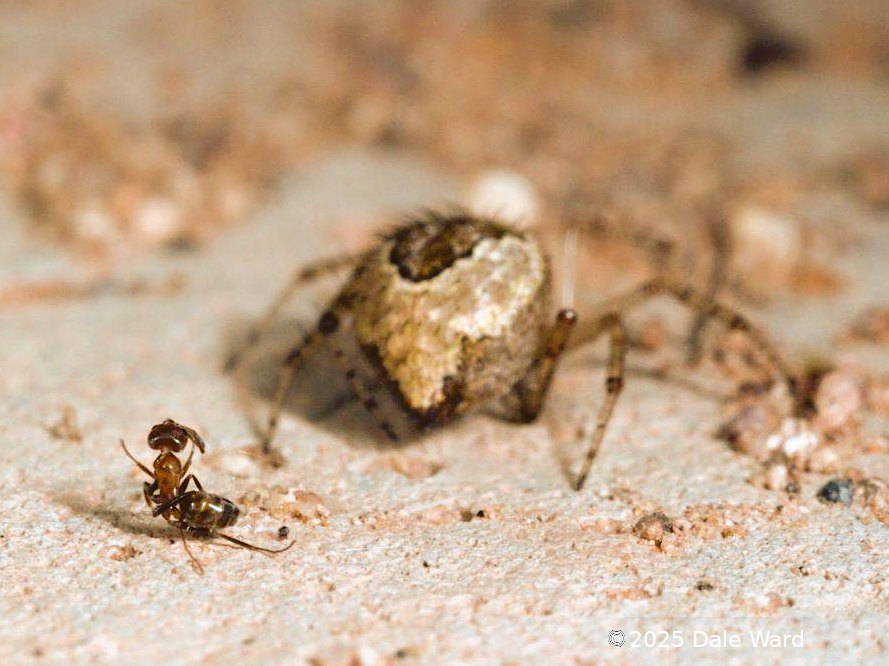 Female _Euryopis_ spider with captured _Forelius pruinousus_ worker
Female _Euryopis_ spider with captured _Forelius pruinousus_ worker
I’m not sure why she did this. Were these failed attempts to drag the ant away with silk? I don’t know.
A male Euryopis approached her during one of her times-away from the ant. The spiders mated.
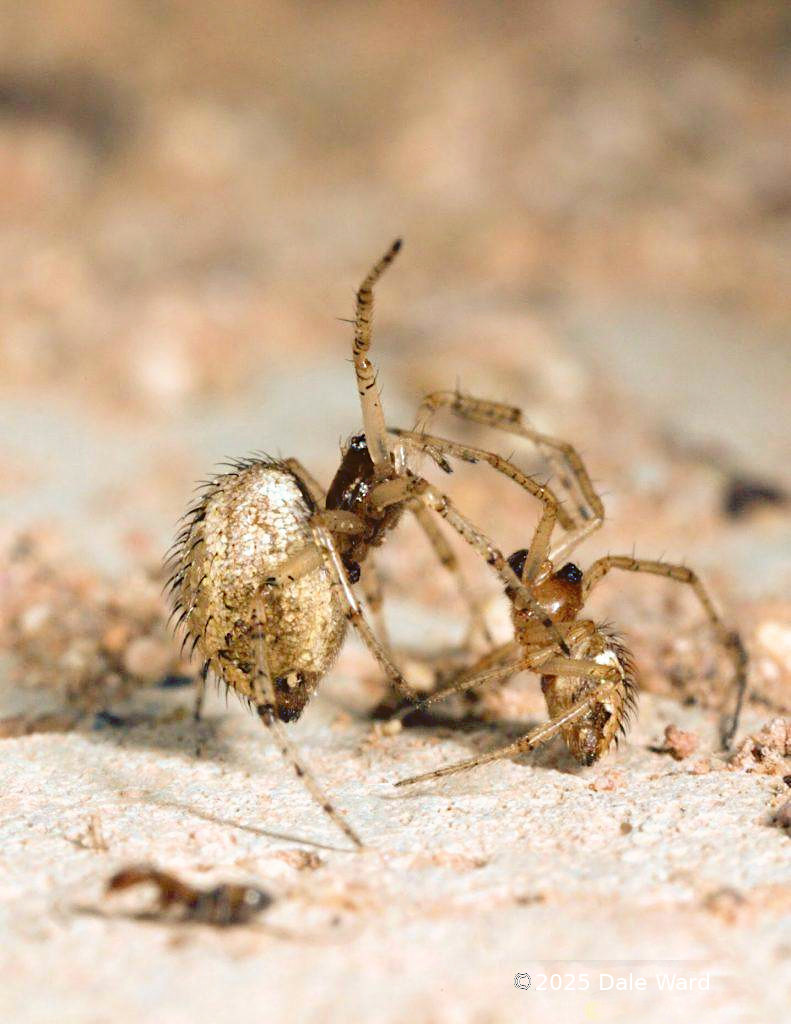 Female (large spider on left) and male (small spider on right) _Euryopis_ spiders mating. Female’s captured _Forelius pruinosus_ ant is in the foreground.
Female (large spider on left) and male (small spider on right) _Euryopis_ spiders mating. Female’s captured _Forelius pruinosus_ ant is in the foreground.
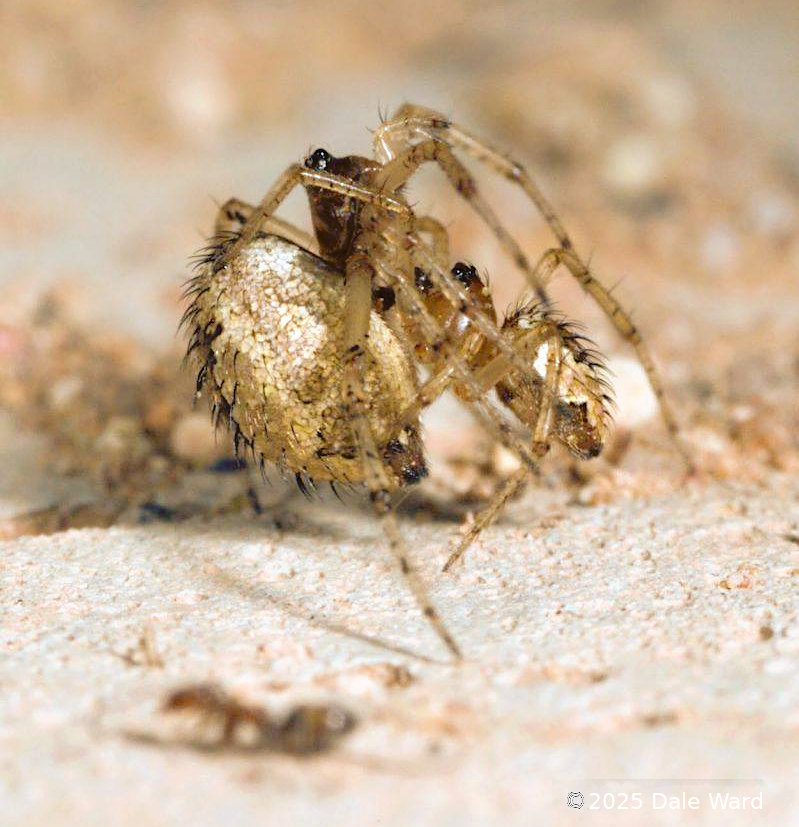 Female (large spider on left) and male (small spider on right) _Euryopis_ spiders mating. Female’s captured _Forelius pruinosus_ ant is in the foreground.
Female (large spider on left) and male (small spider on right) _Euryopis_ spiders mating. Female’s captured _Forelius pruinosus_ ant is in the foreground.
After mating, the male left, and the female returned to the Forelius.
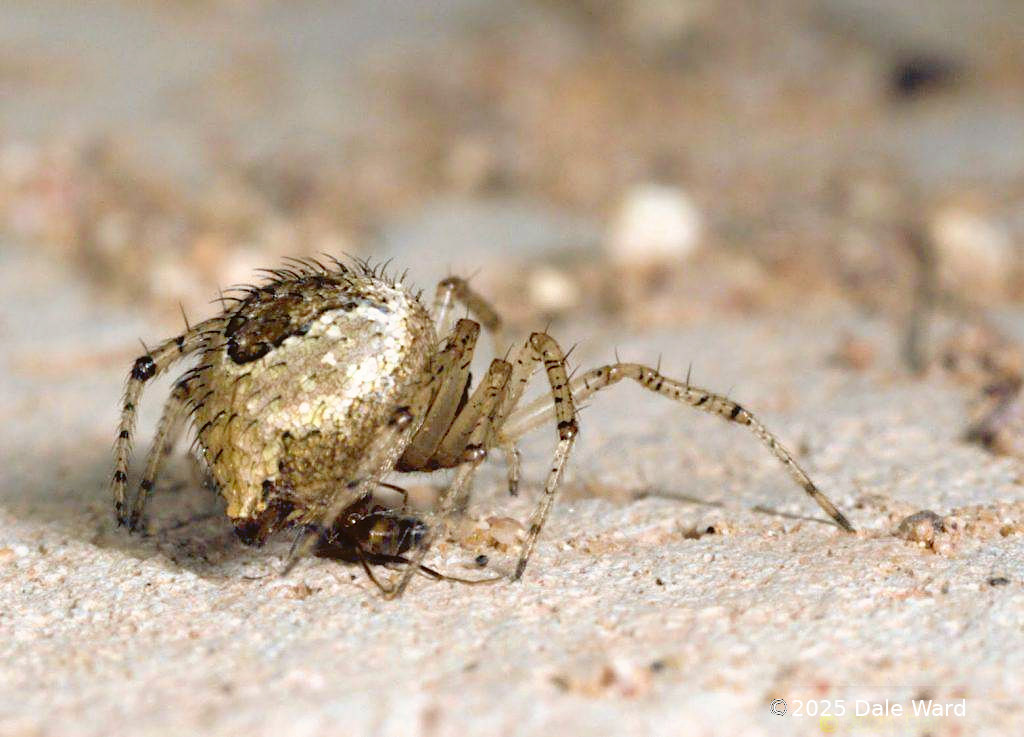 Female _Euryopis_ spider after mating, returning to her captured _Forelius pruinosus_ ant.
Female _Euryopis_ spider after mating, returning to her captured _Forelius pruinosus_ ant.
Eventually, the female Euryopis attached silk to the ant, and the spider dragged the ant away.
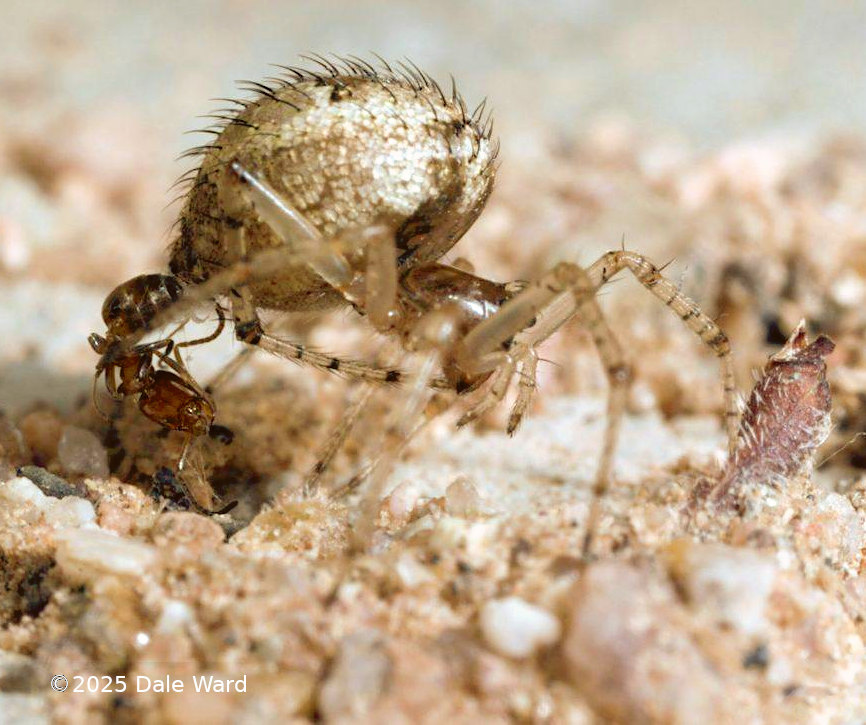 Female _Euryopsis_ spider carries away _Forelius pruinosus_ ant using silk attached to her spinnerets.
Female _Euryopsis_ spider carries away _Forelius pruinosus_ ant using silk attached to her spinnerets.
I concentrated on photographing spiders that were on the vertical edge of the concrete sidewalk, that made it much easier to get low-angle shots. I’d use a flashlight to find the spiders in my camera viewfinder, and to focus on them, then rely on the camera’s flash for the photograph’s main lighting source.
There were a couple of interesting observations about this encounter with Euryopis.
One is that they were feeding on different species of ants. This time it was Pogonomyrmex rugosus and Forelius pruinosus. Other times I’ve seen them, they were feeding on Veromessor pergandei, Solenopsis xyloni and Solenopsis (aurea or amblychila).
That’s a lot of different species of ants. It’s possible that I’m seeing different species of Euryopis in each of these observations, though.
However, on this evening I’d seen the same group of spiders feeding not only on different species of ants, but different subfamilies of ants. Solenopsis, Veromessor and Pogonmyrmex are all in the subfamily Myrmycinae. Forelius is in the Dolichoderinae subfamily. Instead of the sting that Myrmicines often have (Veromessor being the stingless Myrmycine exception in my list of prey ants), Dolichoderines don’t have a sting. Rather, they release quite-unpleasant chemical compounds for their defense.
I would not expect an organism that specializes in preying on ants to willingly cross subfamily boundaries that way…the defenses, and therefore the spider’s countermeasures, would need to be too different. I would think that it would be like like eating an entirely different type of animal.
Especially for an organism such as a spider, which relies on external digestion of their prey. As I understand it, they partially digest their prey while they hold it, then ingest the liquid.
That means they couldn’t easily decide to “not eat this bad bit” of the prey that was spatially near “this good bit” of the prey.
I wonder if these spiders are able to prey on such a range of ants because they avoid eating the gaster of the ants. Maybe Euryopis only eats the head and perhaps the thorax, leaving the poison gland-containing gaster. Note how, when the female’s mouth is near the ants, it’s nearly always near the ants’ head. Also, in this photo of a small Euryopis and Solenopsis xyloni (from a different day), note that the head capsules of the upper ant, the one against the sky, appears to be just empty exoskeleton.
 _Euryopis_ on the cactus spine. It stayed here for as long as a watched it - a couple of minutes, probably. Note the head of the upper _Solenopsis_ - it appears to just be exoskeleton, no contents.
_Euryopis_ on the cactus spine. It stayed here for as long as a watched it - a couple of minutes, probably. Note the head of the upper _Solenopsis_ - it appears to just be exoskeleton, no contents.
Another interesting thing - unlike the time I saw Euryopis preying on Veromessor pergandei in the Spring of the year, this time in the Fall the males did not seem interested in catching prey. They were more interested in mating. They might have been feeding on the females’ ants, but they seemed to treat hunting as secondary to mating.
This suggests that the spiders have a distinct mating season, at least in the Sonoran Desert. And that mating season takes place after the monsoons have been going for a while.
This also suggests that the aggregations at ant nests are not just for feeding - they are also useful to the spiders for mating.
Regarding identification of these spiders to species - I unfortunately did not collect samples of the spiders. After I reading Walter Levy’s excellent 1954 paper on the genus, I’m reasonably certain that I would have little luck with getting a reasonable ID even if I did have samples.
I hang my head and say that I have a couple of tentative IDs for these spiders based solely on the range maps in Dr. Levy’s paper. The candidates are: Euryopis texana, Euryopis lineatipes, or Euryopis scriptipes.
Of these three, I lean towards Euryopis scriptipes based upon the description in Dr. Levy’s paper.
The paper mentions high specimen variability and difficulty in identification several times. He also suggests that the species as they are defined in the paper intergrade with each other, and may actually only be two species. According to Dr. Levy:
A few specimens collected in widely separated localities were described as different species on the basis of variations in color and size. While these differences between many forms are striking, examination of a large series revealed that some forms intergrade into neighboring ones, making the placement of individual specimens often very difficult.
Although the forms are here treated as individual species, there are strong indications that we are dealing with only two species, californica and lineatipes, and subspecies of these. The grouping as done here is only tentative, and further collecting, particularly in the border areas, will probably throw more light on this complex group.
I haven’t read of more recent taxonomic work than the 1954 Levy paper.
This sure sounds like a job for DNA typing, though :)
Sources:
Amanda Hale, Tierney Bougie, Elisa Henderson, Madison Sankovitz, Mari West, et. al. 2018. Notes on hunting behavior of the spider Euryopis californica Banks, 1904 (Aranaeae: Theridiiddae), a novel predator of Veromessor pergandei (Mayr, 1886) harvester ants (Hymenoptera: Formicidae). The Pan-Pacific Entomologist, 94(3): 141-145.
Bockoven, Alison. 2012. Spiders raiding ant nest. This is at Alison’s 6legs2many.wordpress.com blog.
Levy, Herbert Walter. 1954. Spiders of the genus Euryopis from North and Central America (Aranaeae, Theridiidae). American Museum of Natural History Novitates. Number 1666.
Porter, Sanford D. and Eastmond, David A. 1981. Euryopis coki (Theridiidae), A Spider That Preys on Pogonomyrmex Ants. Journal of Arachnology 10:275 (Research Notes).
